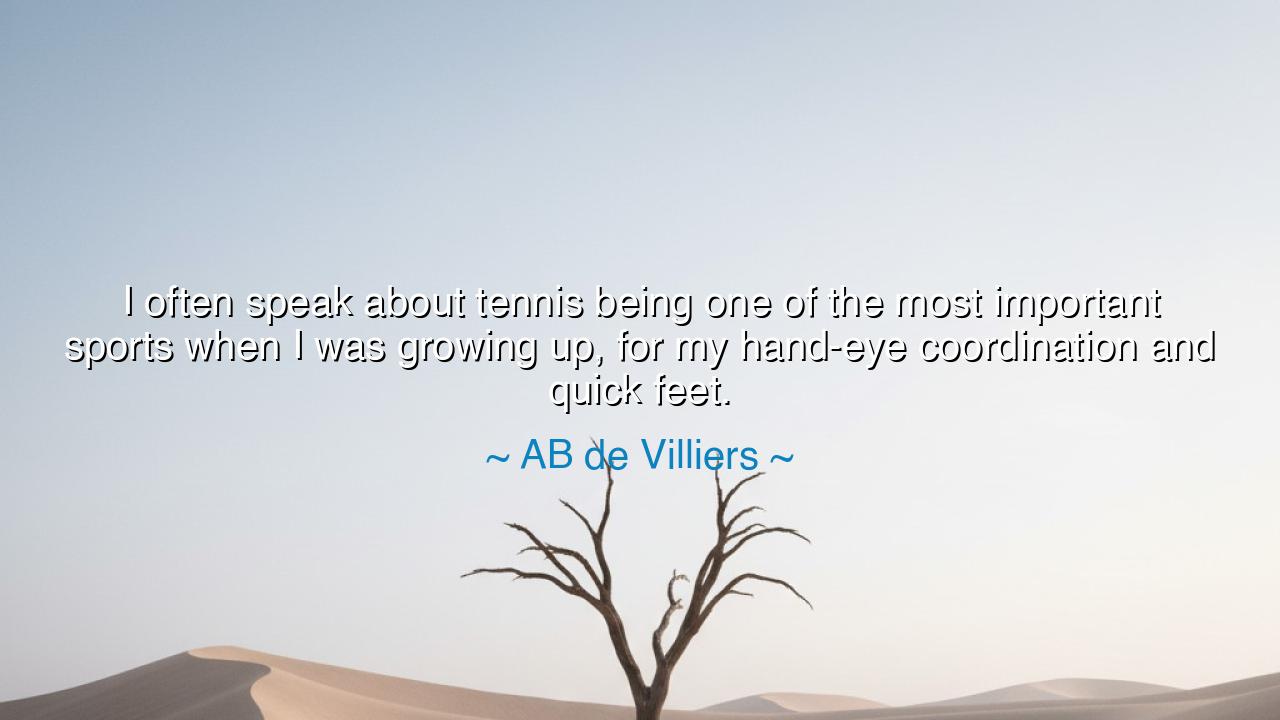
I often speak about tennis being one of the most important
I often speak about tennis being one of the most important sports when I was growing up, for my hand-eye coordination and quick feet.






The celebrated cricketer AB de Villiers once reflected on his formative years: “I often speak about tennis being one of the most important sports when I was growing up, for my hand-eye coordination and quick feet.” In these words, we glimpse a timeless principle: that early experiences in one discipline can lay the foundation for excellence in another. Tennis, for de Villiers, was not merely a pastime; it was a crucible in which his agility, precision, and responsiveness were forged—skills that would later define his greatness on the cricket field.
This quote underscores the interconnection of athletic disciplines and the cultivation of fundamental skills. Hand-eye coordination and quick feet are essential not only in tennis but in myriad human endeavors—sports, music, craftsmanship, and even strategy. De Villiers’ reflection teaches that the virtues cultivated in one arena can become transferable tools, enhancing performance in another. The pursuit of excellence is often a mosaic, where each piece of experience strengthens the whole.
History provides echoes of this truth. Consider Leonardo da Vinci, who trained in painting, engineering, and anatomy simultaneously. Each discipline informed the other: observation of anatomy improved his artistry; his understanding of mechanics enhanced his inventions. Similarly, de Villiers’ training in tennis refined physical attributes that later allowed him to excel in cricket. The principle is enduring: skills developed in one pursuit can enrich mastery in another.
The meaning of de Villiers’ words also touches on foresight and self-awareness. By recognizing the value of tennis for developing coordination and agility, he reveals the importance of intentional practice. True growth arises not merely from participation but from reflection on the purpose of that participation. The young athlete who understands why he trains in one area can carry that benefit forward into all future endeavors.
Even in modern examples, this principle is evident. Roger Federer, though renowned for his dominance in tennis, attributes part of his success to early participation in diverse sports such as soccer and basketball, which honed his footwork and spatial awareness. Similarly, de Villiers demonstrates that foundational skills, honed in one pursuit, become the scaffolding upon which future excellence is built.
The lesson here is profound: cultivate skills broadly, and recognize their potential to enhance other areas of life. For young athletes, artists, and learners, the practical action is clear: engage in diverse disciplines, focus on fundamentals such as coordination, agility, and awareness, and embrace each experience as a building block for future mastery. The value lies not merely in immediate accomplishment but in long-term growth.
Thus, AB de Villiers’ quote endures as wisdom for athletes and aspirants alike. It teaches that early experiences, though sometimes overlooked, can shape the trajectory of a life, and that excellence is often the product of cumulative skill, foresight, and intentional practice. Let us, like de Villiers, cultivate foundational abilities, embrace diverse challenges, and understand that each discipline carries lessons that echo far beyond its immediate arena, guiding us toward mastery in all we pursue.






AAdministratorAdministrator
Welcome, honored guests. Please leave a comment, we will respond soon